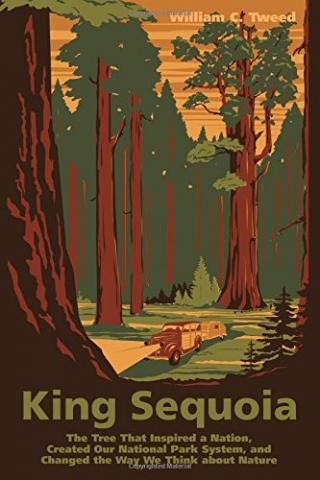One of my favorite spots in California, just a few miles away from the congestion of the Mariposa Grove in Yosemite National Park, is a little known forest glen: Nelder Grove. A century ago this was a logging site, formerly named Fresno Grove, where the towering Sequoias crashed to the ground, to be cut up for grape stakes and fence posts. Massive stumps dot the quiet, verdant hillside, and some giants yet still stand. I always asked myself why, and how, this grove fell, while others went untouched, and were protected.
William Tweed, who spent 30 years with the National Park Service as an historian, writer, and naturalist, has now given me that answer. In his book, King Sequoia (Sierra College Press 2016) Tweed details the long struggles to protect the giant sequoia (Sequoiadendron gigantum) in this wonderful biography of a magnificent species.
The Sequoia is the world's largest single tree, with some specimens reaching nearly 300 feet into the Sierra sky, and 26 feet in diameter. Some individuals are more than 3,000 years old. Tweed describes their first discovery by the 49ers, and Augustus Dowd's description of the Calaveras Grove in 1852. The public, used to tall tales from the Western provinces, were in disbelief, and doubted their existence.
But Tweed describes how the first tree was felled by those unsure how to attack such a giant, and the competition to show the world this symbol of the West by transporting massive samples to New York and England. He also documents the naming of the Sequoia, discounting the popular myth that it was named for Sequoyah, the Native American scribe, and instead describing how it was a scientific name derived from the sequence of its cones. Others attempted to honor leaders from George Washington to the Duke of Wellington too.
And of course there was John Muir. The sage of the Sierra, he was instrumental in not only their protection, but in mapping the tree's range, and Tweed tells of his travails and travels. Others, realizing the potential for this early eco-tourism, created lodges and camps for visitors, such as the famous Wawona Lodge in Yosemite, and its predecessors.
This is a fascinating story; a history that's filled with lumbermen, scientists, railroad owners, and politicians. After the Big Tree's discovery the race was on for either protection or harvest. Tweed does an admirable job describing how some groves found sanctuary in Yosemite, Sequoia, and Kings Canyon national parks (our 2nd, 3rd, and 4th national parks) while other sequoia groves such as the Converse Basin were logged out. (At one point General Grant National Park protected that grove, until its incorporation into Kings Canyon).
The book's dozen maps help locate these groves, parks, and timber camps, but I wish they were more detailed. At times the story of the give-and-take of inclusion, and loss, of these groves may glaze over a reader's eyes, but this history is comprehensive and important. It's political and a powerful statement of how things get done.
The two dozen black and white photographs are helpful, but I wish there were many more, and even some color plates of historic paintings and imagery. Perhaps it can become a bigger, more beautiful book that celebrates this most magnificent tree.







